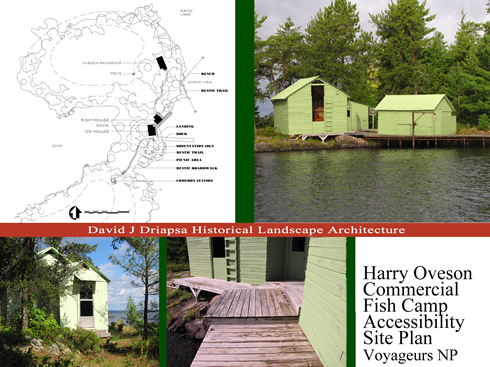
Harry Oveson Commercial Fish Camp
Voyageurs National Park, Minnesota
U.S. National Park Service
The General Management Plan for Voyageurs National Park written in 2002 included the development of 15-20 visitor destinations. These destinations can be reached only by boat and provide visitors with an opportunity to learn about this national park and its significance.
David Driapsa master planned boat docks, accessible trails, picnic facilities and interpretive wayfinding exhibits for these destinations that include historic structures and cultural landscapes being preserved by the National Park Service.
This project meets the provisions of Sections 106 and 110b of the National Historic Preservation Act, requiring federal agencies to produce documentation to HALS standards on sites that are listed in the National Register of Historic Places to mitigate the adverse effects of federal actions such as demolition or substantial alteration.
The work was conducted by David Driapsa serving as project director for Voyageurs National Park Division of Resources Management. He prepared master plans for numerous historic sites in the park, including Harry Oveson's Commercial Fish Camp. Facilities include ADA accessible boat docks, paths, comfort station, picnic tables and interpretative signage. David compiled archival information and site reconnaissance documenting the existing historic landscape, architectural and archeological resources and developed the master plan document. The site is accessible by water.
The master plan assesses existing natural and cultural resources and recommends site organization to enhance visitor experience, interpretation, and programming.
Management of resources and ADA accessibility are critical issues that are addressed, presenting present short- and long-term goals by which the Park Service can meet both goals of accessibility and preservation.
Large-scale commercial fisheries, primarily interested in the production of sturgeon caviar, began in the area in the 1890s, but were short-lived because of the long distance to market, the lack of refrigerated transit and increasing regulation of the industry through time. Small-scale family fishing operations, however, reached a peak in 1910 when the number of licensed fishermen in the area reached forty-eight. After 1910, commercial fishing steadily declined with competing pressure from sport fishermen and additional regulations. By 1942, only ten licensed fishermen operated on Rainy and Namakan Lakes.
Harry Oveson constructed a camp in Cranberry Bay in the late 1950s and had a license to fish whitefish in fifteen sections of Rainy Lake. The ice house at Oveson's is located at water's edge. The thick double walls were insulated with wood shavings and chips, and the floor pit was filled with sawdust. Oveson cut ice from the lake in winter and layered the blocks with sawdust in the ice house, where it would keep for up to two years. Next to the ice house is the fish house, where Oveson filleted the fish to prepare it for packing into wood-plank boxes. Perched on an island on the inside channel of Rainy Lake, the camp has a maritime aspect, especially in foggy or blustery weather, another reminder of Rainy Lake’s size.
Harry Oveson Fish Camp is the only remaining intact commercial fishing camp in the region. Oveson constructed this camp on an island in Cranberry Bay of Rainy Lake in the late 1950s and fished the lake from 1958 to 1985. The Oveson home, an ice house, a fish processing building, and tools of the trade tell the story of commercial fishing on
Rainy Lake. A cove near the fish camp is a wildlife viewing site where visitors observe turtles, beavers, and a variety
of birds, including American eagles.